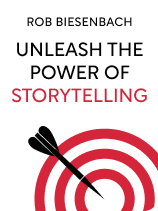

This article is an excerpt from the Shortform book guide to "Unleash the Power of Storytelling" by Rob Biesenbach. Shortform has the world's best summaries and analyses of books you should be reading.
Like this article? Sign up for a free trial here.
Why does a good story need cause and effect? How much should you put into the beginning of your story? Why does your company need its own story?
Everybody knows what a story is. But few of us really understand why stories work or how they can make us better at communicating. In Unleash the Power of Storytelling: Win Hearts, Change Minds, Get Results, Rob Biesenbach breaks a story down into its fundamental pieces.
Read more to learn how you can use storytelling to make any message more engaging and compelling.
Unleash the Power of Storytelling
In Unleash the Power of Storytelling: Win Hearts, Change Minds, Get Results, Rob Biesenbach shows how great storytelling requires a complex balance of content, mechanics, and delivery. But, if you take the time to get it right, you can tell a story that captivates listeners, affects their emotions, and persuades them to act (whether you’re pitching an idea, interviewing for a job, selling a product, or trying to get people behind a social cause).
Biesenbach is a speechwriter and strategist who built a second career as an actor. When he began taking acting classes at The Second City improv theater in Chicago, he realized that the tools that help actors convey emotions and messages onstage could also help his corporate clients communicate more effectively. In the book, he explains exactly how great storytelling and great acting are alike, and how you can use their shared techniques to your advantage.
First, we’ll look at what a story consists of and what pieces make it work. Then we’ll examine why stories have such power to move us, convince us, and get us to act. Finally, we’ll look at how you can create a story that’s perfectly tuned to your audience, matching the story you tell to the message you want them to receive.
What Is a Story?
A story is a narrative that draws its power from its fundamental structure, its delivery, and its ability to affect listeners down to the neural level. We’ll look at the ingredients that Biesenbach identifies as key to a story’s power.
What Are the Essential Elements of a Story?
Biesenbach defines a story as an account of a character who pursues a goal and encounters obstacles along the way. A narrative that lacks one of these fundamental elements (character, goal, and obstacle) isn’t a story and won’t affect listeners like a story can. Because we’re familiar with stories that include a character, a goal, and obstacles, we expect these elements in a story and feel disappointed when those expectations aren’t met.
The character’s efforts in the face of obstacles drive the story forward. A relatable character—one who shares values or circumstances with your audience—makes an abstract brand, mission, or message more concrete. Every story needs a character who embodies the message and makes it more human to listeners.
What Makes a Story Engaging?
Even with those elements in place, Biesenbach says a good story needs some additional characteristics to make it engaging.
An Emotional Appeal
First, a good story appeals to the listener’s emotions. An emotionally relevant story feels more compelling in the moment and remains more memorable later on. Biesenbach points to research findings that memories of emotional events tend to be stronger (and stick around longer) than memories of events that don’t have strong emotions attached. So we remember a story that engages our emotions more clearly than one that doesn’t.
An Accessible Theme
Next, a good story has a theme that people relate to: Even though listeners might have never experienced the situation you’re talking about, the story should call on a universally relatable experience to create common ground.
A Point of View
In addition to telling your listeners something about themselves, a good story tells them something about you. Biesenbach explains that by revealing something about who you are, the right story humanizes you. It illustrates how you see the world, communicates how you’re unique, and makes you memorable.
An Appeal to Values
Finally, a good story transcends its particular details to convey a larger message, often about values you share with your listeners. People who feel involved in your story because of those shared values will remember that story.
Though many of us think we instinctively know how to tell a good story, we often miss the mark. Biesenbach says that, much of the time, that happens because the story is missing one of its essential characteristics. He explains some of the ways that things tend to go wrong:
- If a story doesn’t have a character whom listeners care about, it doesn’t feel like the problem you’re describing affects real people.
- If a story lacks strong conflict (which comes from the tension between the character and the obstacle), it doesn’t hold the audience’s attention.
- If a story doesn’t have high enough stakes, the listener doesn’t feel motivated to learn how the character solves the problem.
- If a story is missing clear cause and effect, the chain of events sounds like a coincidence, which is less meaningful than causality.
If a story doesn’t have an emotional core, the audience doesn’t feel invested in it.
What About the Beginning, Middle, and End?
We tend to think of a story as any narrative with a beginning, a middle, and an end, but Biesenbach thinks that definition of a story is too simplistic. He explains that certain things need to happen at each point in the structure to make a story: The structure of beginning, middle, and end on its own is just a series of events ordered from start to finish.
But, by crafting each of these phases of your story with a specific purpose in mind, you can use that structure to ensure that you have all the essential pieces of a good story. Biesenbach explains how you can map the essential elements of character, goal, and obstacles onto the familiar beginning-middle-end arc:
- At the beginning, set the scene, introduce your character, and set up an event that pushes your character into action to pursue their goal.
- In the middle, show the character working to overcome the obstacles that stand between them and their goal.
- At the end, give the character (and the listener) a resolution: Either the character reaches their goal or they don’t. (Without a resolution, your story will feel anticlimactic, frustrate listeners, and leave them confused about your message.)
Why (and How) Do Good Stories Affect Us?
When Biesenbach talks about the “power of storytelling,” he’s not just talking about a story’s capacity to engage or entertain. He’s also talking about how a story can change people’s minds, affect their emotions, and persuade them to act. Stories have this power because they affect us emotionally, physiologically, and intellectually.
Nature Affects Our Perception of Stories, and Nurture Hones Our Attention to Them
Biesenbach contends that stories affect us powerfully for two reasons: stories are uniquely engaging to our brains’ processes of perception, and we’ve been socially trained to pay attention to stories. To explain how these two influences work, he explains them in terms of “nature” and “nurture” and shows how each can help you tell an engaging story.
The “nature” argument is that a good story captivates you because your brain’s processes of perception are uniquely responsive to stories. Biesenbach cites research that found that a compelling story causes the brain to release a hormone called oxytocin, which enhances our sense of empathy and motivates us to cooperate with others. Researchers have also discovered that listening to a story activates the same regions of the brain that come online when we personally experience the events described in the story.
The “nurture” argument is that stories capture our attention because we learn what to expect from a story very early in life. By early childhood, we’ve learned a set of basic expectations for what will happen in a story: There will be a setup, a climax, and a resolution. When these expectations aren’t met, we feel disappointed. (Think about what it feels like to listen to someone drone on telling an anticlimactic “story” with no conflict, no tension, and no satisfying resolution.)
We Engage Differently With Emotions Than With Facts
In addition to engaging our powers of perception and attention, stories engage our emotions—and emotions are powerful. Provoking an emotional reaction in your listeners can help you persuade them to see things from your point of view—and to take the action that you want them to take. That’s because we respond to emotions very differently than to facts.
Though we think we make decisions by using reason and logic, emotions often motivate or even determine our decisions. If you want your story to motivate your listeners to make a decision, making sure that your story has a solid emotional core is just as important as making sure that you have all your facts straight.
The Power of Story Is Often Abused
Because of the way they engage our perception, attention, and emotion, stories are powerful—so powerful that people use stories to manipulate others. Biesenbach says that when you tell a story, you should resolve to “do no harm,” but many people don’t make such a commitment. Sometimes, people mislead their listeners by focusing their attention on sensationalized anecdotes that contradict the evidence or telling stories that appeal to their audience’s fear or vanity. We should be skeptical of the stories that other people tell. Incentives exist for people, including professional storytellers like marketers, journalists, and political pundits, to exaggerate the drama of a story or to push an overly simplified narrative. It’s wise to check the facts, especially if a story sounds overwhelmingly positive or overwhelmingly negative.
How to Create and Tell a Great Story
After establishing what a good story is and why it’s so powerful, Biesenbach dedicates much of the book to explaining exactly how to create and tell stories. He explains that this is a process that anyone can learn.
Create a Story From Scratch
Biesenbach outlines a process you can use to create a story that matches the audience you need to reach and the message you want to deliver.
Find Story Ideas
First, start cultivating a collection of stories that speak to your values and engage your areas of expertise. Coming up with a story in a pinch can feel difficult, so Biesenbach recommends noticing the stories that play out in your everyday life. It also helps to stay alert to stories in the books, journals, films, and other narratives you consume—you never know when you’ll run across a story that perfectly illustrates one of your core values. You can also interview people about their stories or plumb your own history for stories that relate to the message you want to convey, like calling on a childhood memory of building a treehouse to talk about collaboration.
Consider Your Audience
Next, think about your audience and take an inventory of what you know about your listener. Without a specific listener in mind, you’ll have trouble crafting a story that accomplishes your goals. Consider who they are, what they want, what you have in common with them, and what they know about you or what you represent. Also identify what you’d like your audience to do after hearing your story—adopt your idea, purchase your product, get behind your cause—and any challenges that might stop them from doing so, such as limited time and resources or skepticism about your idea.
Choose Your Character, Goal, Obstacles, and Resolution
Once you have a story and an audience in mind, take some time to think about the character at the heart of your story. Because your character should help you overcome the challenges or objections you anticipate your audience having, the character needs to be relatable to your listeners. Plus, the resolution of the story—where the character either does or doesn’t overcome the obstacles that block the path to the goal—should drive your message home.
Structure and Focus Your Story
Once you’ve chosen a character and you know the basics of what will happen to him, you need to craft the structure of your story. Structure gives shape to the story so that it has conflict and draws the reader into the action. Stories can adopt many different structures, but Biesenbach suggests starting with a simple one that includes:
- Normal state (the status quo)
- Inciting incident (the event that upsets the status quo)
- Turning point (the action the character takes to respond to the inciting event)
- Conflict (the obstacles that complicate the character’s path)
- Resolution (the conclusion, where the character either gets what they want or doesn’t, but in either case learns something)
Use Emotion to Hook Your Audience
Then, when you’ve nailed down the structure, evaluate how your story can tap into listeners’ emotions. Much of a story’s power lies in its ability to make us feel something, and Biesenbach explains that you can use emotion to engage your audience in a few ways.
First, consider what motivates you: Focus less on “what” you do and more on “why” you do it to help center the story on things that matter. If you’re talking about a company or a product, identify the human element in the connections between colleagues or the ties between workers and their communities. You can also connect your story to the values that you and your audience share by emphasizing the importance of community, connecting the story to the values you share, or tapping into the history that unites the members of your audience.
Biesenbach notes that in some cases, it can work to highlight an emotionally resonant lesson in the struggles of a leader, historical figure, or athlete you look up to. (Just watch out for clichés.) And at points throughout your story, it’s OK to express your own emotions: When you talk about the people, memories, and values that you find meaningful, you reveal your own humanity.
Edit Your Story
Finally, it’s time to edit your story. Include only what’s necessary, or else extraneous details will detract from your message and mute the impact of your story. Biesenbach recommends that you stay on message, focusing on the point you want to make with the story and eliminating any details that don’t serve that point. It’s also a good idea to check that you’ve zoomed in on a single character and streamlined the cast of characters in the story as much as possible.
In order to establish a clear cause and effect, which helps the listener follow the logic of your story, make sure that your narrative has just one turning point. Eliminate any confusing twists and turns. Throughout the story, make sure that you’re using detail judiciously. A time and place can set the scene, and sensory details help make the events of the story more vivid, but you can simplify dates, round numbers, and eliminate proper nouns to sharpen the focus.
Deliver Your Story
Creating the perfect story is one thing, but actually telling that story to an audience is another. Biesenbach believes that it’s not just the mechanics of the story but also your delivery of that story that makes it powerful. In fact, he considers the delivery of a story almost as important (though not quite) as its content.
Drawing on his experience as a speechwriter, strategist, and actor, Biesenbach explains how you can optimize the delivery of your story to keep your audience engaged. Most importantly, he recommends treating storytelling as a performance. Perhaps the most important way to do that is to practice your story ahead of time.
Telling a story like a performer also means staying present with your audience and staying connected to the details of the story. Make your voice, expressions, and gestures animated, and keep your storytelling dynamic by varying the words you emphasize, the volume of your voice, and the speed at which you speak. You can also use your body to tell your story: Match your facial expressions to the emotions in the story, use your hands to reinforce what’s happening in the story, and move your body to mark the passage of time.
Finally, making the most of the delivery involves choosing your language thoughtfully. Use sensory words to make your language more vivid and precise, use metaphors to make abstract concepts concrete, and use comparisons to impart a sense of scale with large numbers.
How to Craft Stories for Specific Situations
Telling a great story requires the same elements and calls on the same skills regardless of where you tell the story, and most of Biesenbach’s advice applies pretty much anywhere you’d find yourself in front of an audience.
A Presentation
Biesenbach thinks that stories have an important place in presentations, whether you’re pitching an idea, introducing a product, or giving a lecture. A story can capture your audience’s attention before they know who you are or what you represent and can persuade them to take the action you want them to take.
When you give a presentation, Biesenbach recommends that you should start with a story, end with a story, and tell more stories in between (interspersed with a variety of types of information that communicate your message). Begin your presentation with a story that speaks to a problem your audience cares about—a story that sets up and reinforces the message of the presentation.
Include stories throughout the presentation as needed, making sure to vary the kinds of information that you’re presenting to your audience. (For Biesenbach, this tends to involve one story for each section of the presentation.)
End your presentation with a story that reinforces your message. Biesenbach explains that it can be particularly effective to tell a story that continues the story you told at the beginning of the presentation by adding a twist, appending a postscript, or telling it from another character’s point of view.
A Company Origin Story
When you need to talk about your company and the work you do, a great story plays a crucial role in holding your audience’s interest. Biesenbach explains that businesses, nonprofits, and other organizations need an “origin story” that presents their history and purpose and humanizes the people behind the scenes. A story is more compelling and memorable than a dry corporate timeline, which typically just lists dates and milestones without a narrative arc to connect them.
When you’re telling a corporate story, you need to tailor the story to what the company can do for the audience. Like any good story, this kind of story needs a relatable character and a clear theme. Biesenbach notes you should pick just one value proposition to focus on rather than trying to address everything the company does. Many company origin stories follow a familiar pattern, which you can adapt:
- The founder encounters a problem.
- They make a discovery or invent a solution.
- They turn their idea into a product or service.
- They grow their business.
- The business continues to operate on its original values.
Company origin stories that follow Biesenbach’s template are everywhere, including behind some of your favorite products.
Your Own Story
When you interview for a job or introduce yourself to someone new, you should frame your career as a story. This makes it more memorable, reveals why you do what you do, and can even help explain an unconventional path if needed. Having a story is also useful when you’re facing a crisis or a decision and need help staying focused on your priorities. Biesenbach cites the advice to find the “implicit narrative” of your life: Identify the values, character traits, and skills that have driven you through your most significant successes and challenges. Recall feedback that you’ve received from others, and articulate what you’ve enjoyed about your work.
Biesenbach recommends crafting your personal narrative with the same basic five-part structure he recommends for any story. At the beginning of your story, you’re enjoying your status quo. Then, an inciting incident disrupts that status quo. Next, the story comes to a turning point, where you respond to the inciting incident. Conflict occurs as you face challenges. At the end, you reach a resolution.
A Toast or Eulogy
You can use a story to frame your thoughts when you need to make a toast, speak on a special occasion, or deliver a eulogy. The sentiment you want to communicate can be more impactful in a story, and the momentum of a story can also help you get through an emotional moment.
When you know you’ll need to speak at an emotional moment, Biesenbach recommends practicing your story, bringing your notes with you, pausing if you lose your composure, and minimizing eye contact if it helps you get through the speech.
When composing a eulogy, Biesenbach recommends focusing on one character trait and telling a story that illustrates it. Then, you can explain the impact that that particular incident made on you. If you’re speaking about someone with whom you have a complicated relationship, focus on one thing that you find admirable about the person and speak honestly about it.

———End of Preview———
Like what you just read? Read the rest of the world's best book summary and analysis of Rob Biesenbach's "Unleash the Power of Storytelling" at Shortform.
Here's what you'll find in our full Unleash the Power of Storytelling summary:
- How telling a story can make any message more compelling
- The unique power stories have to influence us and shape our emotions
- The crucial pieces that make up a story (other than the beginning, middle, and end)






